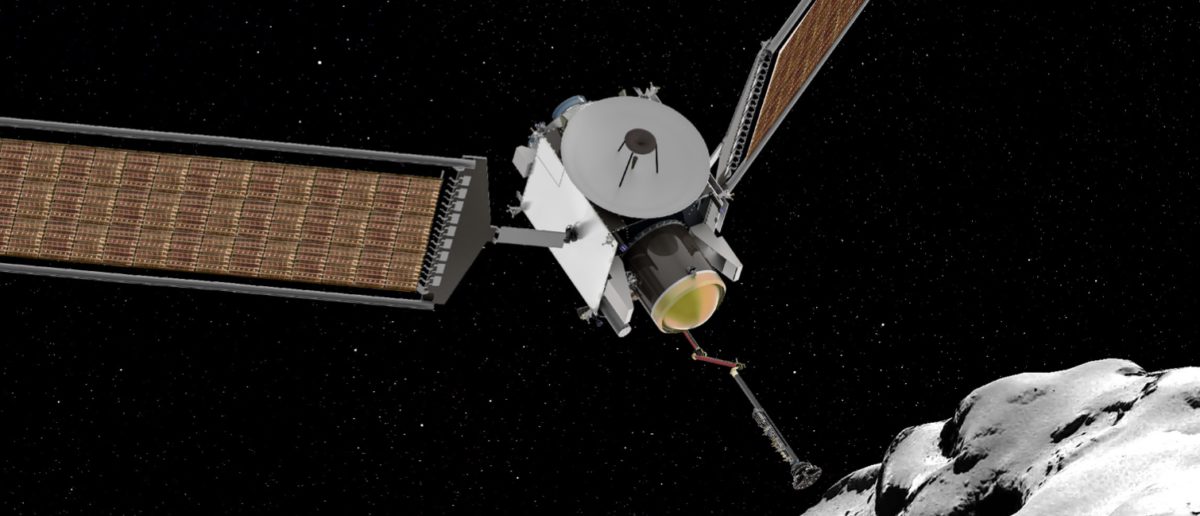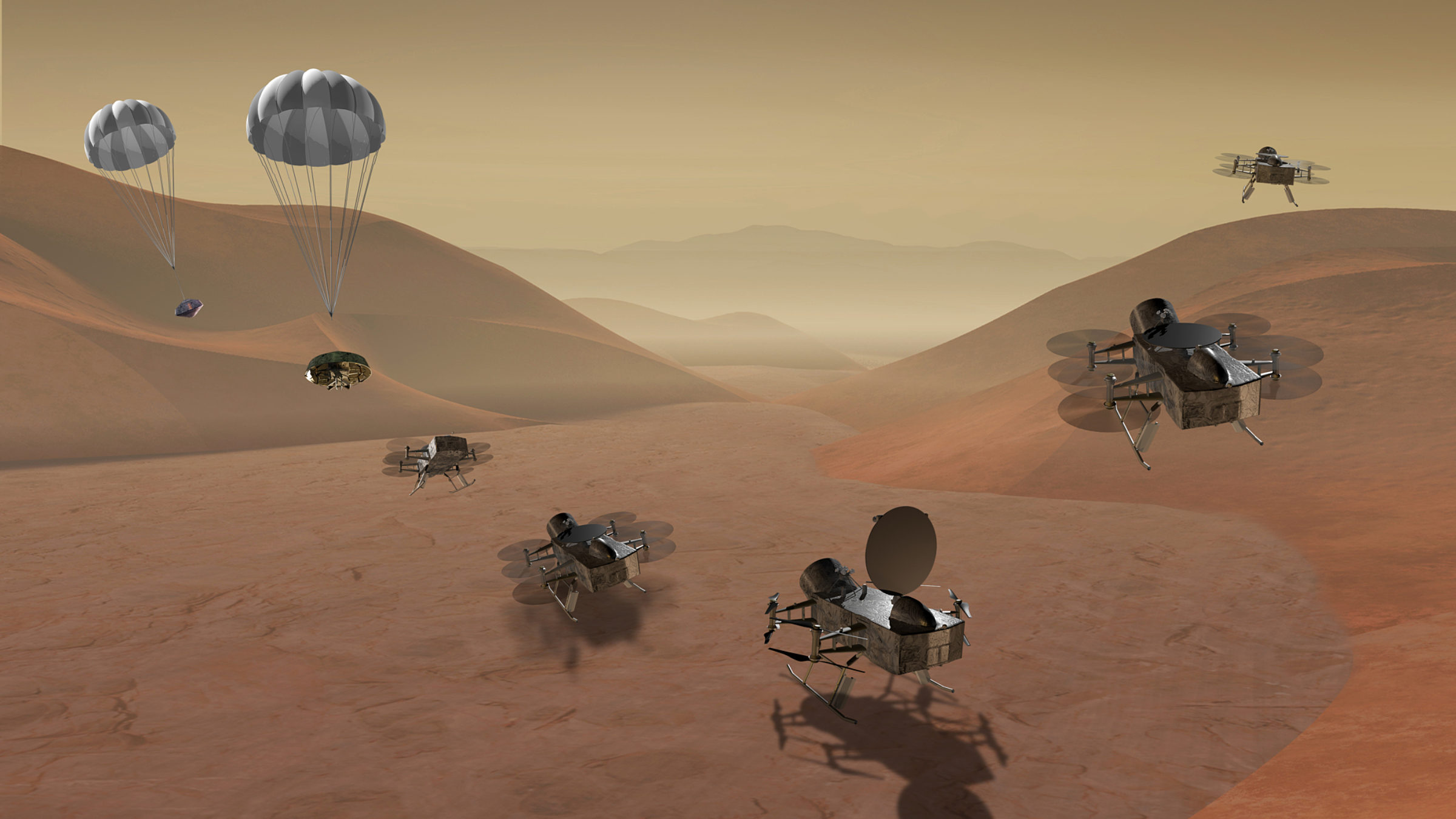Jason Davis • Dec 20, 2017
Downselect: NASA narrows future mission destination to comet 67P or Titan
NASA today narrowed its list of contenders for a future planetary exploration mission to two concepts: CAESAR, a cometary sample return, and Dragonfly, a drone to explore Saturn's moon Titan. The agency will fund both missions through 2018 before making a final selection in mid-2019, with launch scheduled for the mid-2020s.
The two finalists were picked from a roster of 12 proposals to send spacecraft to Venus, the Moon, a comet, Saturn, Enceladus, or Titan. Two other left-out missions will also receive technology development funding: VICI, a set of dual Venus landers, and ELSAH, a spacecraft to sniff out life in Enceladus’ plumes.


CAESAR, which stands for Comet Astrobiology Exploration Sample Return, is a mission proposed by Steve Squyres of Cornell University. CAESAR would return a sample from 67P/Churyumov-Gerasimenko, the same comet Europe's Rosetta spacecraft explored between 2014 and 2016. As Van Kane explained in a previous article, "by returning to this richly-studied comet, scientists will be able to understand the samples acquired within the context of the entire body."
The Dragonfly proposal is led by Elizabeth Turtle at the Johns Hopkins University Applied Physics Laboratory. The mission involves a dual-quadcopter drone that would fly around Titan and sample various surface locations—some of them hundreds of miles apart!
CAESAR and Dragonfly are now vying for the fourth selection under NASA’s New Frontiers selection. As I wrote previously:
Every 10 years, the planetary science community prioritizes all the questions they want to answer during the next decade, laying them out in a long report called the Decadal Survey.
There are three types of planetary missions: Flagship, New Frontiers, and Discovery. Flagship missions are planned at the agency level, while New Frontiers and Discovery missions are competitively selected. New Frontiers missions are cost-capped at around a billion dollars, and Discovery missions go for about a half-billion.
There's no set-in-stone rule for how often each type of mission gets picked, but a rough approximation is that NASA picks a Flagship mission once per decade, a New Frontiers mission every five or six years, and a Discovery mission every two or three years. The last New Frontiers selection was OSIRIS-REx in 2011, and the last Discovery selection was Lucy and Psyche in January 2017.
When NASA says it's ready to fund a new New Frontiers or Discovery mission, it puts out a call for proposals that align with the destinations and science questions in the Decadal Survey. Unfortunately, NASA doesn't have enough money to send missions to all those places at once, so it ultimately has to decide which proposed mission has the best chance of succeeding at answering the questions the Decadal Survey lists for its destination.
I asked our director of space policy, Casey Dreier, to weigh in on today’s news. Here are his thoughts:
The current Decadal Survey report recommended five New Frontiers mission types, and notably did not include a mission to Titan or Enceladus. NASA revised the acceptable mission list in 2016 to include missions to ocean worlds, providing an opening for missions like Dragonfly, in response to increasing scientific and public interest in the moons of the outer solar system. Many in the Titan community felt shut out of the decadal process last time, as their flagship mission concept was rejected for being too expensive while there was no mid-sized mission option to compete for. Today is a win for ocean worlds, even if this mission does not ultimately get selected.
Given the Moon focus of the Trump administration, it was surprising to see the that the lunar sample return concept (one of the decadal-recommended missions) did not make it to the final round. In the previous New Frontiers competition, the Moonrise sample return proposal reached the final round but lost out to OSIRIS-REx. Given the amount of maturity, investment, and development in that project, I was surprised to see this did not make the final cut. It is possible—some would argue even likely—that lunar science missions will see additional funding options in whatever new framework NASA will develop to achieve our new national space policy.
And what more can one say about Venus? A mission there was once again cut out, and the Venusian community will have to wait for yet another mission selection round. The next opportunity will be the upcoming Discovery selection in 2020. There were two Venus missions that made it to the final selection last time, so those have a good shot at another selection. The additional technology funding provided to VICI may help the Venus community be competitive in the next round, but even if Venus wins, a mission wouldn’t launch until 2025 or so, enshrining a minimum three-decade-long gap in NASA-led missions to our Earth-ish neighbor.
New Frontiers and Discovery missions are PI (principal investigator)-led. The PI and proposing team don't have to be based at NASA—they can also be from a university or institution. Proposers spend years refining their mission concepts and working through the selection process. That means while today is an exciting day for the teams behind the winning proposals, it's a bitter disappointment for the losing teams.
Here's a quick sample of some of the range of emotions from Twitter. If you had a stake in one of the missions, it paid to be prepared:
Prepared for any combination of outcomes pic.twitter.com/DgiE71FgSP
— Sarah Hörst (@PlanetDr) December 20, 2017
You can't see the picture in this tweet, but it's Lucy pulling a football away from Charlie Brown in the comic strip Peanuts. New Horizons PI Alan Stern, who spent years getting a Pluto mission approved, sympathized:
Hang in there Dave. Plutonproves persostence pays.
— AlanStern (@AlanStern) December 20, 2017
Others were mad about Venus:
Did you know the last time we went to Venus the data from the DSN was recorded onto physical tapes and when they were collected, were flown from each DSN location to JPL for the science team to review? Yeah, it's been that long. pic.twitter.com/Eus9DxTGe7
— Shannon Stirone (@shannonmstirone) December 20, 2017
Europe's space agency wanted to remind everyone that while there hasn't been a NASA mission to Venus since Magellan, other countries have sent missions:
The European Space Agency (@esa) would like you to remember that NASA isn't the only one who has sent probes to Venus. I got you, @esa - much ❤️ for Venus Express!
— Ariel Waldman (@arielwaldman) December 20, 2017
Also, Japan (@JAXA_en) has a probe at Venus RIGHT NOW: https://t.co/WqnFxvUDFx pic.twitter.com/n0ocaG28e9
Finally, some of the proposers who lost out today are already looking ahead:
Sad to see that Venus lost out again. I'm proud to be part of the VOX team - @SueSmrekar did a fantastic job as PI. While writing the proposal was the craziest 4 months of my life, it was all worth it. We will not give up!
— Jorn (@Planetguy_Bln) December 20, 2017
The Time is Now.
As a Planetary Defender, you’re part of our mission to decrease the risk of Earth being hit by an asteroid or comet.
Donate Today

 Explore Worlds
Explore Worlds Find Life
Find Life Defend Earth
Defend Earth

